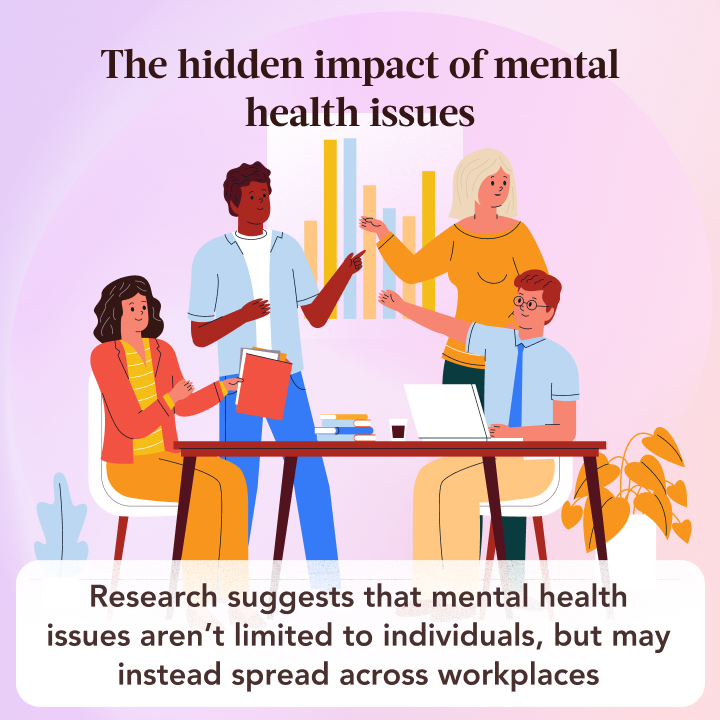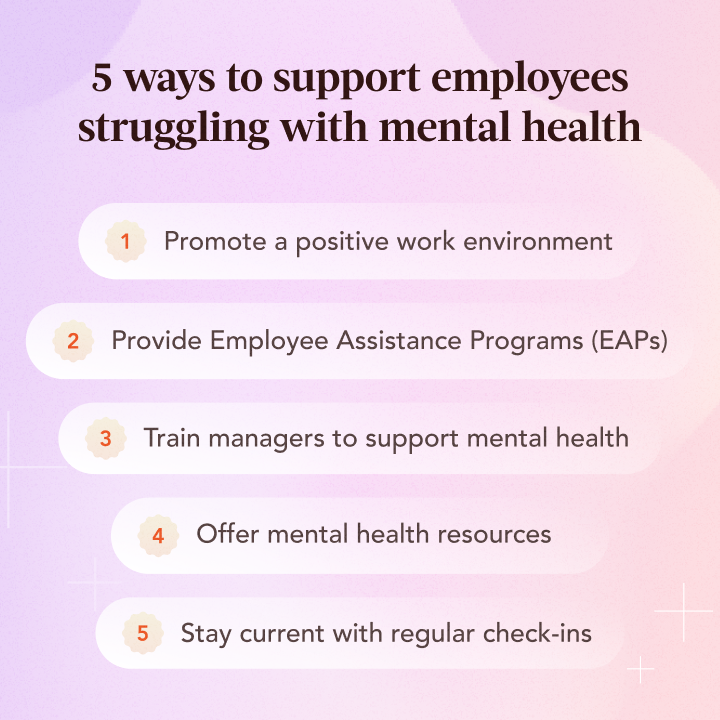How to Support an Employee Struggling with Mental Health

As the demands on our time increase while sources of stress compound, employee mental health support has become an important, yet all-too-often overlooked, element of business success.
Untreated mental health issues can significantly impact businesses—the World Health Organization reports that depression and anxiety alone cost the global economy an estimated $1 trillion per year in lost productivity.
On the flip side, businesses that prioritize mental health see promising results. According to the Centers for Disease Control and Prevention, for every $1 invested in mental health programs, there’s an average $4 return in improved health and productivity.
By understanding and supporting employee mental health needs, businesses can unlock a happier, healthier, and more productive workforce, and turn a potential threat into a powerful opportunity.
In this post, we'll explore actionable ways to do just that.
The hidden impact of mental health issues in the workplace
Research published in Administrative Science Quarterly indicates that mental health difficulties can be contagious. The study, which involved an analysis of 250,000 employees over a span of 12 years, revealed that organizations with an initially high prevalence of mental health conditions among their workforce tend to "implant" their employees with depression, anxiety, and stress-related disorders. This means that other team members are more likely to develop similar mental health conditions.
Interestingly, the study further suggests that even after leaving such an organization, an employee could potentially act as a "vector," carrying mental health conditions into their next workplace. When a new employee with low mental well-being joins a different organization, they could inadvertently increase the risk of their new colleagues developing similar mental health issues.
The research particularly highlights the role of managers, identifying them as "super-spreaders" who can more readily transmit low mental well-being within organizations.
In other words, research suggests that mental health issues aren’t limited to individuals, but may instead spread across workplaces, posing greater issues for the business as a whole if left untreated.

The benefits of supporting employee mental health
In addition to enhanced satisfaction and productivity, investing in mental health support can bring many additional benefits to businesses. Healthy workplaces often see a reduced turnover rate, as employees who feel supported are more likely to stay with the company.
A positive company culture can also enhance a company’s reputation, attracting top talent and potential clients. Mental health support may also lead to improved decision-making, as employees free from constant stress or anxiety are better equipped to make sound decisions.
The question isn't whether we can afford to support mental health in the workplace, but whether we can afford not to.
5 ways to support an employee struggling with mental health
Business leaders and managers are in a tough position. Today’s employees grapple with a spectrum of mental health issues, including anxiety, depression, burnout, trauma, and PTSD. How these mental health experiences manifest may vary widely based on factors like race, economic status, citizenship, job roles, parenting and caregiving duties, and many other variables.
So, how can leaders assist their team members as they contend with these challenges? Here are 5 tips to support an employee struggling with mental health.

1 Promote a positive work environment
Big shifts in workplace culture are built on small moments of positivity that can be expressed across many dimensions. Businesses can actively cultivate a culture that values mental health by creating an environment that encourages openness, inclusivity, and mutual respect. This means taking action to reduce any lingering stigma around mental health, and openly recognizing mental health and wellness as a vital part of each individual’s overall well-being.
A positive work environment is built on consistent, everyday actions. It can be achieved by promoting positive interactions, engaging in team-building activities, and advocating for respectful communication. This kind of environment not only supports those who may be struggling, but also helps to prevent mental health issues from arising in the first place.
2 Provide Employee Assistance Programs (EAPs)
EAPs are critical resources that offer help to employees dealing with personal issues, including those related to mental health. These programs often provide confidential counseling, mental health assessments, and referral services to external professionals when needed.
By regularly promoting EAPs, businesses ensure that employees are aware of the mental health support available to them, and feel comfortable seeking help when they need it. An effective EAP can significantly contribute to the well-being and productivity of the workforce.
3 Train managers to support mental health
Mental health is a specialized topic and involves an important set of skills. It's crucial that managers be properly trained to recognize signs of mental health issues among their team members, and understand how to respond appropriately.
Training should equip managers with skills to foster supportive relationships with their team, address concerns, and direct employees to appropriate resources when needed.
Additionally, proper training helps managers to understand the critical role they play in creating a mentally healthy work environment. A well-trained manager can act as a first line of defense, identifying issues early and facilitating timely interventions.
4 Offer mental health resources
Companies can support their employees by offering resources such as workshops, webinars, and literature on mental health topics. Regularly sharing these resources with employees raises awareness, provides useful coping strategies, and educates employees on how to support colleagues who may be struggling.
Proactively sharing resources can also help to normalize conversations around mental health, showing employees that they're not alone in their struggles and that it's okay to seek help. And these valuable resources can be a lifeline for employees who might otherwise not know where to turn.
5 Stay current with regular check-ins
Regular one-on-one check-ins help managers gauge the mental well-being of their employees. These meetings provide an opportunity for employees to express any concerns or challenges they're facing, and let employees know that the company genuinely cares about their well-being.
Despite constant shifts and uncertainty across today’s business landscape, a leader’s core responsibility remains unchanged: to provide support to their team, and that includes fostering good mental health and wellness.
How Frankly can help
Frankly’s EAP solution is an innovative, evidence-based mental health and wellness solution that supports employees, benefits workplace environments as a whole, and delivers savings for employers. Our EAP provides employees with direct, flexible access to the right mix of mental health coaching, therapy, psychiatry services, and mental wellness resources for their specific needs.
Implementing Frankly’s comprehensive mental health and mindfulness program can deliver substantial value for employers, while empowering employees to thrive and accomplish their goals. To find out more, book a 15 minute demo.
